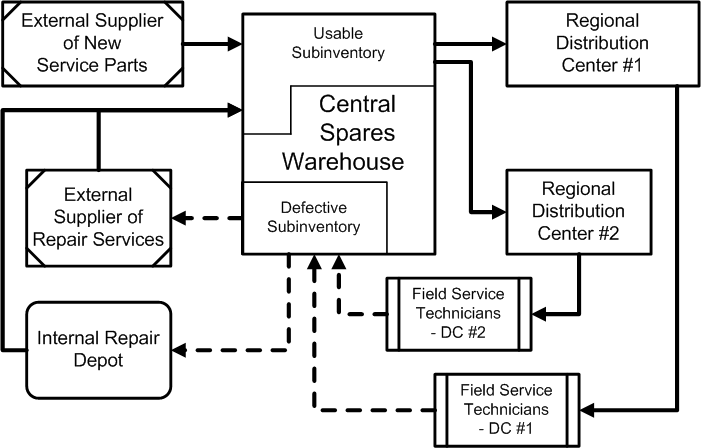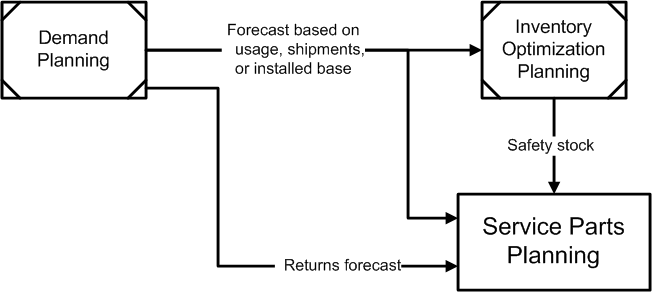Introduction
Business Need
Repair service operations need service parts planning systems to ensure that the right parts are at the right locations, at the right times, and in the right (usable) condition, while being consistent with inventory budgets and service level targets.
Service parts inventory management differs from product inventory management; hence the need for functionality designed to handle special service parts situations such as: reverse flow of potentially repairable parts, combinations of stock-keeping units (SKUs) and locations, mission-critical parts, and intermittent demand.
Complex rules govern the service supply chain planning process. The overall business requirement is to supply needed repair parts from the lowest cost source first:
-
Exhaust existing on-hand inventory, then
-
Evaluate transfer of on-hand inventory from other locations, then
-
Evaluate repair of defective parts, then
-
Procure new parts.
The Service (Repair) Parts Planning module (SPP) of the Oracle Value Chain Planning (VCP) suite enables you to plan service-centric supply chains.
Service Parts Planning:
-
Accommodates planning for service organizations from the central warehouse to trunk stock, and from the service technicians' stock of defective parts back to warehouse locations for defective parts.
-
Optimizes repair and new-buy decisions, while considering item supersession and product substitutions.
-
Spans both short- and long-term planning horizons.
-
Generates customizable, business-specific exceptions and recommendation messages for carrying out the plan.
Supply Chain Modeling
The following figure illustrates an example supply chain for service planning and execution. The solid arrows represent forward material flow of usable spare parts. Dashed arrows represent material flow of repairable defective parts.

Supply Chain Organizations Modeled by SPP
Based on the example supply chain, service part plans cover the following organizations:
-
External supplier of new parts (new buy)
-
External supplier of repair services
-
Internal Depot Repair
-
Central spares warehouse
-
Central defective warehouse, if any
-
-
Regional warehouses (replenishing organizations)
-
Regional defective warehouses, if any
-
Oracle Spares Management generates plans governing field service organizations and field technician trunk stock.
See Modeling Field Service Technician Organizations.
The transfer rules between supply chain organizations ensure that service part requirements are replenished.
Modeling Repair Supplier Organizations
To enable multicompany planning and execution in the reverse supply chain, if the supply base consists of external repair suppliers, the repair supplier must be associated with an organization. For repair returns planning, repair inventory is usually stored at a defective warehouse and pulled to the supplier site as required.
In the service supply chain, the repair supplier can be managed as a:
-
Push – preposition relationship
In Push relationships, all defectives are prepositioned at the repair supplier site, based on (monthly or quarterly) contract agreements.
-
Pull – On demand return or repair return relationship
In Pull relationships, the defectives are moved for repair only when a demand occurs at the replenishing organization.
With this set up, the same supplier organization can be used to plan items for both Pull and Push relationships.
For more information about repair programs and supplier relationships, see the Oracle Spares Management User Guide.
For more information about the relationship between repair programs and repair lead time, see Repair Program Influence on Service Supply Chain Lead Time Offset.
Modeling Depot Repair Organizations
Service Parts Planning supports two business flows for depot organization planning:
-
Field service flow
The depot organization does not start the repair unless and until a need arises at the warehouse. In the field service flow, depot repair internal organizations perform repair operations. Depot repair organizations are defined as separate organizations in the service supply chain. This means that parts move in and out of the repair organization before and after the repair.
-
Customer returns flow
The Depot Repair organization repairs, and then returns the same part to the customer. In the customer returns flow, service planning uses historical data of spare part consumption to forecast spare parts that are required to perform repairs. Because in a depot organization, planning forecasts independent material requirements, planning does not use bills of material and routings to plan for component requirements.
When an actual return of a part occurs, service execution (Depot Repair) creates a repair work order to repair the product, and then adds components as required.
For planning purposes, key requirements for Depot Repair include:
-
Generating forecasts for spare parts
-
Planning based on part condition
-
Netting existing repair work orders
-
Generating planned orders for repair, and to move inventory in and out if required
Defining Default Subinventories at the Repair Organizations
All repair organizations, whether internal or external, must include at least one defective and one usable subinventory that is netable. These definitions reside in the Field Service Spares Management module of the E-Business Suite.
When you manually raise internal sales orders (ISOs) to move material, Spares Management and Depot Repair ensure that ISOs to move the defective outbound shipments have an attached defective subinventory. This identifies and defines the movement of defective items in the supply chain.
Defective and Usable Subinventories
The supply chain model segregates usable parts from defective parts into subinventories that are designated in the E-Business Suite as either usable or defective.
No restrictions are placed by the system on the central warehouse with respect to defective parts. This means that the defectives can:
-
Be stocked in a separate organization, or
-
Exist in the same organization, but in designated subinventories.
Modeling Field Service Technician Organizations
Field service technician organizations and customer organizations are not modeled in Service Parts Planning.
Oracle Spares Management generates plans governing field service organizations and field technician trunk stock. This functionality includes prescribing inventory replenishment policies for the service technician’s trunk stock, return of excess and defective inventory, and sharing inventory between technicians.
Spares Management models field technicians as customer and customer site organizations. Usable and defective inventory in the field service technicians’ trunk stock are modeled as technician organization subinventories. All internal sales orders for outbound shipments raised from technician organizations carry the technician’s name as a customer name and the subinventory location as the customer site. All ISO outbound shipments from the field move material to the designated subinventory and location (trunk stock).
Subinventory Owners
Service Parts Planning is not affected by subinventory ownership. In Spares Management, the association between a subinventory and a technician (employee) is a many-to-many relationship. In cases in which one subinventory ties to multiple technicians, then the default owner attaches as the technician for that subinventory. If internal sales orders (outbound shipments) and internal requisitions (inbound shipments) from field organizations do not have an attached subinventory, then these orders and requisitions are attached to the default customer and customer site, as in an ordinary transfer.
Service Parts Planning does not plan for field service technician organizations, but does plan for all other entities.
Related Topics
See Supply Chain Organizations Modeled by SPP.
Solution Overview
The primary supply chain management processes and decisions are:
| - | Spares Demand and Supply Forecasting |
|---|---|
| 1 | Forecast demand for spares at the regional distribution centers. |
| 2 | Forecast supply of defective returns to the central warehouse (sub inventory). Generate demand and supply forecasts for spare part items in the replenishing organizations based on either historical data or installed population data. Historical data can be either shipments to the field or usage in the field. Complementary forecasting functionality available in Oracle Demantra Demand Management supports both forecasting processes. See the Oracle Demantra Demand Management Users Guide. |
| - | Service Parts Planning (for Warehouses |
| 3 | Establish the need for spares supply at central and distribution warehouses. Set inventory policies for spare part items, either by using Oracle Inventory Optimization (I/O) planning or by manually defining safety stock item attributes. |
| 4 | Determine the source of spares supply, whether new, external repair, or internal repair. Generate action message recommendations to balance supply with demand for each quantity and due date. Satisfy highest demand priority first. Use the following sequence of supply: a) Consume on-hand inventory located at the demand organization. b) Commit on-order supplies at the demand organization. c) Consider using supersession parts, if applicable. d) Use sourcing rules tied to the latest item revision to determine the next source of supply:
|
| 5 | Execute sourcing recommendations. |
| - | Spares Management (for Field Service) |
| 6 | Establish replenishment policy for individual technicians. |
| 7 | Execute replenishment for technicians. |
| 8 | Schedule field service. |
| 9 | Debrief and return defective spare parts to central warehouse. |
Complementary planning functionality available in Oracle Field Service Spares Management covers primary processes #6 through #9 as they relate to field service organizations and technicians’ trunk stock. See the Oracle Spares Management Users Guide.
Service Supply Chain Forecasting Modes
The Service Parts Planning solution supports both traditional and inline forecasting modes:
A demand planning system generates a demand forecast that serves as a demand schedule input to the service parts plan, and where implemented, also to the inventory optimization plan. The demand planning system also generates a returns forecast that serves as a supply schedule input to the service parts plan.

In this scenario, the Service Part Planning system uses Oracle Demantra Demand Management functionality to generate both the service parts demand and defective returns supply forecasts.

-
In either mode, forecasts can be based on usage history, shipment history, or returns history.
-
In the case of new product introductions or similar situations where there is insufficient history for a reliable basis, the inline mode provides the ability to base forecasts on the item’s install base population and average failure rate.
Solution Integration
The Service Parts Planning solution integrates with the following Oracle products:
-
Oracle Demantra Demand Management
-
Oracle Order Management
-
Oracle Procurement
-
Oracle Inventory
-
Oracle VCP Inventory Optimization – optional
Oracle products that depend on Service Parts Planning are:
-
Oracle Field Service Spares Management
-
Oracle Depot Repair
Setup Sequence
This part of the guide describes the sequence of steps to set up Service Parts Planning:
-
Set up source instance and destination instance data.
-
Set relevant item and organization attributes.
-
-
Collecting Source Data (to SPP)
-
Collect service part usage, returns, install base history, inventory balances, and transactional data such as sales orders and purchase orders.
-
View collected data; the demand data report is enabled.
-
-
Set Up Inline forecasts . Otherwise, forecasts are entered as a Demand Schedule from a demand planning system.
-
Create forecasting rules (in SPP).
- Create forecasting rules in service supply chain setup. - Assign forecast method and define basis for calculating the forecast. -
(Optional) Change the forecast parameter default values for the selected forecast method.
-
Assign forecast rules to items.
- Use items query to choose items. - Update or change the forecast rule assigned to these items.
-
-
Set up the service plan.
-
Associate categories of items and organizations for the plan.
-
Assign forecast scenarios.
-
Choose all relevant plan option attributes.
-
Create product - part relationships. – This is done on the Failure Rate window on the Destination (SPP) side, not on the source side.
-
Set up Sourcing Rules, Assignment Sets, Item Attributes, and so on.
For more information about setup, see the Oracle Advanced Supply Chain Planning Implementation and User Guide.
